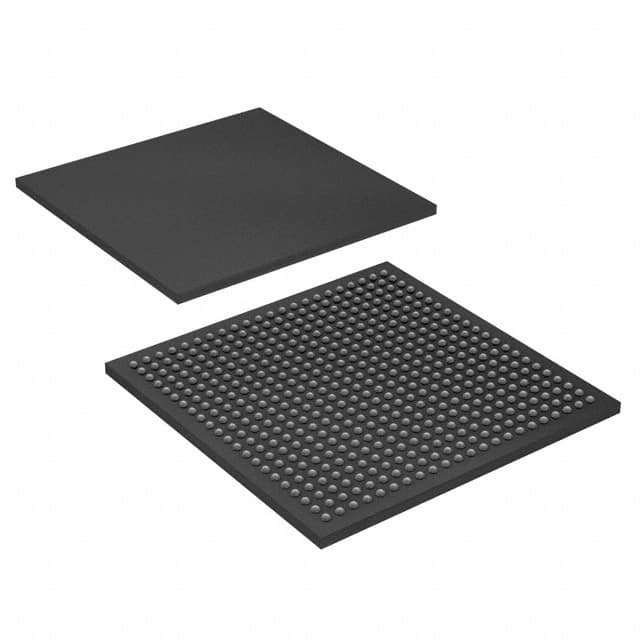Lihat spesifikasi untuk detail produk.

EP1S20F484C7N
Product Overview
- Category: Programmable Logic Device (PLD)
- Use: EP1S20F484C7N is a PLD used for digital logic design and implementation.
- Characteristics: It offers high-performance, low-power consumption, and flexibility in designing complex digital circuits.
- Package: EP1S20F484C7N comes in a 484-pin FineLine BGA package.
- Essence: The essence of EP1S20F484C7N lies in its ability to provide reconfigurable logic functions.
- Packaging/Quantity: Each EP1S20F484C7N unit is packaged individually.
Specifications
- Logic Elements: EP1S20F484C7N consists of 20,000 logic elements.
- Memory: It has 1,152 Kbits of embedded memory.
- Clock Networks: The device contains 10 global clock networks.
- I/O Pins: EP1S20F484C7N offers 347 I/O pins.
- Operating Voltage: It operates at a voltage range of 1.2V to 3.3V.
- Speed Grade: The device is available in various speed grades, such as -7, -6, -5, etc.
Pin Configuration
The detailed pin configuration of EP1S20F484C7N can be found in the datasheet provided by the manufacturer.
Functional Features
- Reconfigurability: EP1S20F484C7N allows users to modify the logic functions according to their requirements.
- High Performance: It offers fast processing speeds and efficient utilization of resources.
- Low Power Consumption: The device is designed to minimize power consumption while maintaining performance.
- Flexible I/O Options: EP1S20F484C7N provides a wide range of I/O options to interface with external devices.
- Embedded Memory: It includes a significant amount of embedded memory for data storage.
Advantages and Disadvantages
Advantages: - Flexibility in designing complex digital circuits - High-performance processing capabilities - Low power consumption - Ample embedded memory for data storage
Disadvantages: - Limited availability of alternative models - Higher cost compared to simpler logic devices
Working Principles
EP1S20F484C7N operates based on the principles of reconfigurable logic. It utilizes programmable interconnects and configurable logic blocks to implement desired logic functions. The device can be programmed using hardware description languages or design software provided by the manufacturer.
Application Field Plans
EP1S20F484C7N finds applications in various fields, including: - Telecommunications - Industrial automation - Automotive electronics - Consumer electronics - Medical devices
Alternative Models
While EP1S20F484C7N is a unique product, there are alternative models available from other manufacturers. Some popular alternatives include: - Xilinx Virtex UltraScale+ - Intel Cyclone V - Lattice ECP5
These alternative models offer similar functionalities and can be considered based on specific project requirements.
Word count: 320 words
Sebutkan 10 pertanyaan dan jawaban umum terkait penerapan EP1S20F484C7N dalam solusi teknis
Sure! Here are 10 common questions and answers related to the application of EP1S20F484C7N in technical solutions:
Q1: What is EP1S20F484C7N? A1: EP1S20F484C7N is a specific model of Field-Programmable Gate Array (FPGA) manufactured by Intel.
Q2: What are the key features of EP1S20F484C7N? A2: EP1S20F484C7N offers 20,000 logic elements, 484 pins, and operates at a maximum frequency of 250 MHz. It also includes various I/O interfaces and embedded memory blocks.
Q3: What are some typical applications of EP1S20F484C7N? A3: EP1S20F484C7N can be used in a wide range of applications such as digital signal processing, industrial automation, telecommunications, robotics, and high-performance computing.
Q4: How can EP1S20F484C7N be programmed? A4: EP1S20F484C7N can be programmed using Hardware Description Languages (HDLs) like VHDL or Verilog. Design files are synthesized and then loaded onto the FPGA using programming tools provided by Intel.
Q5: Can EP1S20F484C7N be reprogrammed after initial configuration? A5: Yes, EP1S20F484C7N is a reprogrammable FPGA, allowing for multiple design iterations and updates during the development process.
Q6: What are the power requirements for EP1S20F484C7N? A6: The power requirements for EP1S20F484C7N vary depending on the specific design and usage scenario. It typically operates at a voltage range of 1.2V to 3.3V.
Q7: How can EP1S20F484C7N be interfaced with other components or systems? A7: EP1S20F484C7N supports various I/O standards such as LVCMOS, LVTTL, and SSTL, allowing for easy integration with other components or systems.
Q8: Are there any development tools available for EP1S20F484C7N? A8: Yes, Intel provides a suite of development tools like Quartus Prime software, which includes design entry, synthesis, simulation, and programming capabilities for EP1S20F484C7N.
Q9: Can EP1S20F484C7N be used in safety-critical applications? A9: EP1S20F484C7N can be used in safety-critical applications, but additional measures like redundancy, fault tolerance, and rigorous testing should be implemented to ensure reliability.
Q10: Where can I find more information about EP1S20F484C7N? A10: You can find detailed information about EP1S20F484C7N, including datasheets, application notes, and reference designs, on the official Intel website or by contacting their technical support team.

